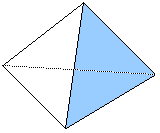Tetrahedron faces
One face of a regular tetrahedron is painted blue and each of the
remaining faces are painted using one of the colours red, green or
yellow. How many different possibilities are there?
Problem
One face of a regular tetrahedron is painted blue and each of the remaining faces are painted using one of the colours red, green or yellow.
Image

How many different possibilities are there, if we count those that just differ by a rotation as the same?
How many different possibilities would there be if the tetrahedron was irregular?
Getting Started
Where could the other
colours go?
Can you find another way?
How do you know the tetrahedra are different?
How will you record your tetrahedra?
Can you find another way?
How do you know the tetrahedra are different?
How will you record your tetrahedra?
Student Solutions
Some children from Carr head Primary School sent in this solution. It's actually a solution to a different question being asked - they worked on not having to use each of the 4 colours for each arrangement. We have included it here as it's shows a really good piece of work. Here is what they wrote:-
I am writing to you because we think that we (9 kids from Carr Head Primary School) have found a solution for your tetrahedron question and here's how we did it. Has anybody else found a solution yet?
First we split into 3 different groups, Elliott, Ben B and Oliver were in one group but we started by making a 3D tetrahedron. Second we coloured them with all the colours properly, then we numbered the faces.
Next we put the first letters of the colours (B,G,Y,R) and put the numbers of the faces
B G Y R
1 2 3 4
Then swapped them around like 1,3,2,4 but we noticed that we were rotating it. An answer was 24 but that was wrong.
Here is the table that works. This doesn't rotate and the answer would be 10 because you only have 1 blue all the time and it needed 4 of all the colours added up.

If you try this, then do send us what you find out.
I am writing to you because we think that we (9 kids from Carr Head Primary School) have found a solution for your tetrahedron question and here's how we did it. Has anybody else found a solution yet?
First we split into 3 different groups, Elliott, Ben B and Oliver were in one group but we started by making a 3D tetrahedron. Second we coloured them with all the colours properly, then we numbered the faces.
Next we put the first letters of the colours (B,G,Y,R) and put the numbers of the faces
B G Y R
1 2 3 4
Then swapped them around like 1,3,2,4 but we noticed that we were rotating it. An answer was 24 but that was wrong.
Here is the table that works. This doesn't rotate and the answer would be 10 because you only have 1 blue all the time and it needed 4 of all the colours added up.
Image

If you try this, then do send us what you find out.
Teachers' Resources
Why do this problem?
This problem offers opportunities for children to visualise a
3D shape. It also encourages conjectures and justifications.
Possible approach
To begin with, encourage children to make conjectures about
the number of different tetrahedra, asking pairs of children to
come up with justifications for their ideas.
Having polydron available for children to make tetrahedra
would be helpful. Alternatively, stickers could be stuck on
ready-made tetrahedra. Children might also want to draw nets so
isometric dotty paper would be useful.
Key questions
Where could the other
colours go?
Can you find another way?
How do you know the tetrahedra are different?
How will you record your tetrahedra?
